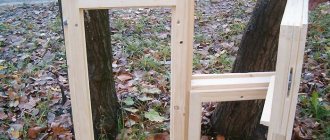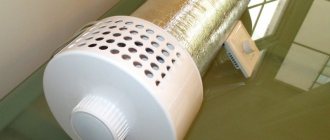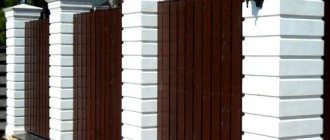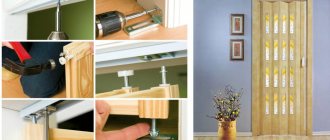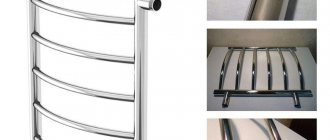Pleated paper blinds in the shape of a semicircle
Having decided to understand the question of how to make blinds, it is worth recognizing that one of the most inexpensive and easiest to manufacture are blinds made of paper using the pleated method.
They make it easy to refresh the interior or protect window glass during renovation work.
To make this type of curtains you will need:
Work should be performed on a flat, free surface.
Instructions on how to make pleated blinds with your own hands are as follows:
Prepare a paper strip.
Its width should exceed the dimensions of the window sash by 0.5 cm on each side. Draw strips of the required width (up to 4 cm) on the back of a sheet of paper. It should be remembered that the wider the strip, the more massive the blinds will look.
Fold the paper where the lines were drawn. If the paper is very thick, you can first use a ruler to draw sharp scissors along it so that the folds are more even.
Fold the entire strip of paper into an accordion shape and secure the edges and middle with clamps.
Measure the middle of the resulting structure and pierce it through with an awl. Insert a cord into it. Tie a knot or fasten a button in the upper part.
To make the base more rigid, glue cardboard strips to its outer slats. Thread the fasteners into the bottom of the cord. Using double-sided tape, glue the blinds to the inside of the cornice. Attach tape to the tip of the bottom edge of the blinds and make the bottom in the shape of a semicircle.
Preparation and measurements
To install blinds you will need the following tools:
- screwdriver or screwdriver;
- pencil or marker;
- roulette.
To ensure that all your efforts are not in vain, it is important to carry out the measurements correctly and accurately - only then will the design work effectively. In addition, it must be located absolutely symmetrically to the glass unit. Blinds attached with adhesive tape are more tolerant of errors - they can be corrected if desired. For analogues with self-tapping screws, additional holes will need to be made, which is unlikely to benefit the beauty of the window; flaws here are unacceptable.
At the first stage of installing blinds, measure the width and height of the window
To correctly position the structure relative to the window and floor level, you will need to measure the following parameters:
- window opening dimensions;
- length to the bottom edge of the curtain;
- distance between fasteners.
For horizontal blinds installed on sashes, you will need to additionally measure the dimensions of each glass. To the results obtained, add 2 cm to the top and bottom edges and 0.5 cm to the sides .
Installation methods
Methods for installing blinds
For industrially manufactured models, do-it-yourself installation of blinds is described in the attached instructions. When independently choosing the place where the product will be mounted, all the parts (for example, brackets) are not always used.
Hanging on the opening
The desire to completely hide the window involves installing blinds over its upper part. In this case, brackets are used that will provide the gap from the blinds to the wall necessary for the free movement of the slats.
The effect of curtains is created by attaching the box (top bar) to the ceiling. There are already holes made in the cornice through which you need to screw it to the ceiling.
Before installing the blinds, mark the centers of the opening to be closed and the top of the curtain to be secured. I set aside equal distances from them for drilling holes where the fixing grips will be installed.
If you have to hang blinds with an electric drive for the movement of the slats, then you need to take into account that the dimensions of the folded package on the right and left are different, depending on the location of the motor.
Window mount
Let's consider ways to correctly install the selected curtain option without changing its performance characteristics.
It is allowed to install blinds on plastic windows using screws on the structural profile and glazing bead. Before screwing in, it is advisable to pre-drill the plastic body with a drill whose Ø is smaller than the screw thread. This will prevent the material from cracking due to excessive twisting force.
If you are installing horizontal blinds on a separate sash, then you also need to install a fixing device from below - bushings through which a tension line will be threaded to tension the fixed panel.
The manufacturer allows you to choose how to install horizontal roller blinds. The kit includes double-sided tape that firmly fixes the plastic brackets to the window profile. Below, glue holders for a fully unraveled fabric curtain to the window with your own hands.
Inter-frame installation of horizontal blinds will require drilling holes for the control mechanism in a convenient part of the transom according to the manufacturer’s diagram attached to the product. For more information about installing horizontal blinds, watch this video:
A non-damaging way to answer the question of how to hang blinds on indoor plastic windows is with special hooks hung along the top of the frame. They may be sold with the product.
The last stage of installation
The installation of horizontal blinds is completed by assembling all the elements into a functioning structure. A description of how to assemble the blinds is included with each model. Large bays on the installed cornice are inserted into the latches until they click; the drive is carried out by a cord threaded into a special fastening for the blinds, which directs the free movement forward/backward. To learn how to attach blinds to a mount without screws, watch this video:
After assembly, be sure to check how the blinds are attached by making several trial lowering and raising of the blinders. All questionable areas must be re-secured to prevent future damage.
Concept and types of blinds
Operating principle and control mechanism of blinds
How to properly measure blinds for plastic windows
Installing fasteners for blinds to the ceiling and wall
The right choice of blinds for plastic windows
Tips for choosing slats for blinds
Inter-frame curtains
Inter-frame curtains are used only for double frames. Installation of blinds of this type is somewhat more complicated than the previous ones, and the process itself will result in an inevitable violation of the integrity of the profile: you will have to drill at least two holes through which the handle and cord to control the system will be cut out.
The curtains themselves are mounted in the inner sash, or more precisely, in its upper part, and the bracket is mounted directly to the upper profile. Installing the structure is in many ways similar to working with horizontal blinds.
Inter-frame curtains are installed in double glazing
Do-it-yourself installation of the system is carried out according to the following algorithm:
- The window frame unwinds and the blinds are applied to the inner sash. This is used to check the size matches.
- Markings are made for fastening, as well as points for the cord and control handle, after which holes with a diameter of about 5 mm are drilled.
- The brackets are inserted into the calipers, the cords and control handles are brought out, with the cord through the lower hole.
- Inter-frame blinds are mounted on the sash with special inter-frame brackets.
- An adapter is installed on the frame, and a control handle is connected to the flexible terminal.
- The control handle and cord lock is installed.
- The frame twists back.
The blinds control element is brought out through the frame.
As you can see, the technology for installing blinds on plastic windows without drilling is completely unsuitable here. The principle itself is similar to the installation of all other design options, with the only difference being that you have to disassemble the frame, screw the bracket into the interframe space, and remove the controls through the drilled holes.
Installation instructions without drilling
To install it yourself, you don’t need any tools or even skills; it’s important to correctly calculate the width of the canvas and attach it evenly to the surface
For clamps
Installation on special brackets-clamps is perhaps the easiest way to hang blinds with your own hands, but this mounting option is only possible on an opening window sash:
- assemble the cornice and canvas according to the manufacturer’s instructions;
- put clamps on the cornice, check that they do not touch moving elements and do not interfere with the movement of cords and chains;
- attach the cornice to the sash, mark with a simple pencil where to hang the brackets;
- unfold the canvas, check whether it touches the protruding elements of the window; if necessary, the curtain must be adjusted to size: cut to width and shortened;
- unclip the clamps from the cornice, open the sash and put on the brackets according to the marks, make sure that they are tight and level;
- You can fasten the curtain rod and the canvas to it.
The diagram shows one of the options for hanging blinds without drilling
On tape
If you are looking for a simple and at the same time reliable way to hang blinds on a plastic window with your own hands and not damage the profile, then the option of attaching with tape is the most optimal
Here it is important to glue the cornice correctly so that the canvas hangs straight down, without distortions, otherwise there will be unsightly overlaps and gaps on the sides and bottom, in the end the blinds will quickly break
Installation steps:
- assemble the blinds according to the attached diagram;
- try it on the window, if necessary, cut it on the side and along the length, taking into account that the minimum gap between the panel and the protruding elements of the window is 5-10 mm;
- mark the extreme points of the cornice;
- draw a line between them, ideally it should be strictly parallel to the window sill;
- if the geometry of the opening is not ideal, make a plumb line from a rope and a weight, attach it to the marks, mark the side lines where the edges of the canvas will go, and straighten the line along which the cornice will be glued, it is better to have a slight distortion at the top and bottom than ugly gaps and overlaps on the sides;
- wipe the place where the cornice is fixed with solvent or acetone;
- remove the protective film from the double-sided tape and glue the cornice strictly along the line;
- check the operation of the canvas; if it catches somewhere, then it would be correct to remove the system, clean the installation site and re-glue it.
Sometimes the tape is not glued to the cornice, but the kit comes with special fasteners with a magnet or hooks. Installation of such a model occurs according to an identical scheme described above.
The video clearly demonstrates that even a child or a woman can glue blinds with tape.
Installation on non-standard openings
Vertical blinds can be installed on sloping and non-standard openings; they are also actively used in zoning space.
To create a curved opening, bendable guides are used to hang the slats; to fix them to the surface, it is necessary to install holders every 200-600 mm, depending on the shape of the bends and the weight of the blinds.
When installing vertical blinds with your own hands on a sloping opening, it is important that the slats move when the canvas is opened from the high side to the low. Installation is carried out as follows:
- we assemble blinds and hang slats;
- apply it in place, outline which line to cut the strips along;
- remove the slats from the runners and adjust them to size;
- return the stripes to the runners;
- we place the assembled blinds over the opening;
- mark the space for the bottom bracket;
- make a hole, insert a plastic dowel element, attach the bottom bracket;
- We hook the guide to the canvas and, moving it up/down, adjust the position of the upper bracket so that the lower edge of the curtain is strictly parallel to the window sill or floor.
It is better to cut vertical slats to size on sloping openings after the blinds are installed
And be sure to watch the video review of vertical blinds in the interior.
We hang aluminum curtains and blinds on sliding windows
For installation you will need a set of tools: wire, drill, Phillips screwdriver, screwdriver, drawing supplies.
The instructions for installing blinds on sliding windows contain a list of items that are carried out step by step:
Draw a marking line for installing brackets. It must take into account the distance between the clamps and the control mechanism, between the brackets (from 60 cm) and to the extreme areas on the blinds (25 cm). For large blinds and significant weight, it is recommended to use intermediate fasteners.
Drill holes for installing dowels on the surface to which you plan to attach the brackets. It is possible to use blinds on plastic windows without drilling.
Profile installation.
Fixing the top rod of the blinds on the brackets
It is important to remember that the blinds at this stage are already assembled.
Working with aluminum options on inclined surfaces requires a little more effort and skill.
Useful tips
In order for blinds to serve for many years, you should follow some operating rules:
- When purchasing, you should carefully check the package and all equipment, especially fasteners. They must be of high quality.
- You should choose the adjustment mechanism wisely - it should be on the side that is convenient for use.
- Make sure that no one opens the windows while the blinds are not yet fully closed.
- The rotary handle must not interfere with or touch other fittings.
- Don't forget about periodic maintenance.
- It is quite possible to install blinds on windows yourself, but it is better to entrust its repair to a professional.
- Plastic structures are preferable: they are much easier to care for.
- You should not clean the system too often, this will only lead to rapid wear of the protective layer.
Installing the device yourself, as you can see, is not a difficult task at all, be it metal, plastic or wooden blinds on plastic windows. The main thing is to have quality instructions at hand. Thanks to this material, you can hang your blinds as quickly and efficiently as possible.
How to properly install plastic vertical blinds
Basically, vertical blinds are mounted in front of the window opening. In this case, the most important thing is to maintain the distance from the opening to the blind mechanism. It must be sufficient so that the strips can turn without interference. The distance is determined depending on the width of the stripes.
To install blinds on windows by hand you will need:
- Dowels and screws – up to 5 pieces measuring 6.0x40 mm.
- Drill or hammer drill with a drill bit with a diameter of 6 mm.
- Screwdriver.
As a rule, blinds are sold disassembled (the cornice with the mechanism is separate from the fabric strips).
Attaching the cornice itself can be done in two ways:
- To the ceiling.
- To the wall using special brackets.
The procedure for attaching the cornice to the ceiling is as follows:
- The first step is to mark the position of the cornice. A certain distance is removed from the wall and a mark is made on the ceiling. The same ones are applied along the entire length of the cornice in increments of no more than 1 meter.
- A straight line is carefully drawn through the marks. You can use painter's lace for this.
- Now, inside the cornice itself, holes with a diameter of 3.5 mm are drilled in increments of 0.5 meters. A self-tapping screw will be screwed into the dowel through them.
- Once the holes are drilled, you can begin “trying on” the cornice. To do this, you will need the help of one more person. The cornice is applied along the line and through the holes drilled in it, the same ones are drilled in the ceiling with a drill with a diameter of 3.5 mm. Then the cornice is laid aside, and the resulting holes are drilled to a diameter of 6 mm.
- Next, dowels are driven into the resulting holes. This must be done in such a way that the edge of the dowel does not protrude from the hole. Then the cornice is installed in place and screwed in place.
- Once the cornice is installed, you can hang the rest of the blinds on it.
- If the ceiling is made of plasterboard, then it is advisable to attach the cornice to the sheathing profiles using self-tapping screws. If this is not possible, the cornice is attached directly to the drywall using a special dowel.
- In some situations, it is not possible to attach vertical blinds to the ceiling, for example, if the latter is made of PVC film (so-called stretch ceilings). In this case, it is mounted on the wall using brackets. The curtain rod has special threaded holes, thanks to which brackets are attached to it.
- The brackets themselves are mounted on the wall above the window opening. Before starting work, it is necessary to make markings for the level so that they are installed at the same height. The brackets are attached to the wall using dowels.
Types of blinds and how to choose them?
The modern market offers many types of blinds. They differ from each other in size, shape, direction of the strips themselves, material of manufacture and even color.
In general there are three main types:
- horizontal;
- vertical;
- roll
Horizontal. This type is most suitable for residential premises. Such blinds can be attached both inside the window, on each of its sashes, and outside, covering the entire window. Such blinds combine perfectly with curtains and practically do not occupy the window sill space.
Roller blinds perform the same functions as simple horizontal blinds, but the fabric base itself makes them lighter and more elegant
Vertical. The difference between this type of blinds is that they can be attached not only to the window itself along its outer part, but even to the ceiling. They create an adequate replacement for tulle curtains. However, this type creates an “office” look, and therefore is not used so often for residential premises. However, for rooms with low ceilings, these blinds are perfect. They will help to visually increase the size of the room, this is due to the fact that the structure completely covers the window.
These blinds are perfect for rooms with low ceilings.
Rolled. Thanks to a variety of colors, these blinds are perfect for any design solution. They perform the same functions as simple horizontal blinds, but the fabric base itself makes them lighter and more elegant. They are attached simply - with adhesive tape, using self-tapping screws that are screwed to glazing beads or brackets.
Installation instructions
To hang blinds on tape or clips, you don’t need to drill holes, so you can handle the task yourself.
It is important that the brackets do not touch the moving part of the rollers and cords inside the curtain rod. Before installation, be sure to try on the fasteners and, in this form, attach the blinds to the window to mark the location of installation of brackets or clamps
Installation on tape
You can install regular and cassette blinds using tape, the only difference is in the fastening, the installation technology is identical
It is important to ensure reliable adhesion here, so the surface should be properly prepared:
- be sure to wash the window frame and dry it well so that dust and debris do not get under the tape;
- treat the installation site with a degreaser; according to reviews from experts and home craftsmen, acetone is best suited for this.
To hang a regular model, you need to attach special platforms to the profile. The adhesive tape is already glued to the parts; you just need to remove the protective layer and attach the pad in place to the prepared surface. Next, a holder with grooves is hung on it, onto which the cornice is fastened.
The diagram shows the installation of blinds on tape; the method is suitable for attaching light-weight structures
Horizontal cassette blinds are also installed using double-sided tape. The adhesive strip is located on the inside of the box on the top bar and on the sides
Here it is important to place the cornice evenly against the frame and press it tightly. To avoid distortions, it is recommended to put marks on top, which will serve as guidelines
Hanging blinds with tape with your own hands is very simple, but this method does not leave room for error. If the curtains are installed unevenly, you will have to remove the structure, tear off the tape and re-stick it. Be sure to watch the video tips from the master; he explains all the nuances of installing cassette curtain rods with tape.
How to hang blinds on plastic brackets
Plastic brackets for hanging blinds come in the form of hooks or brackets, it all depends on the design features of the cornice. The hooks are installed on the top of the frame, and brackets are attached to them in grooves, onto which the blinds are placed.
Diagram of how to attach blinds to hook brackets
The clips have a more rigid fixation and are suitable for installing small horizontal blinds, including pleated blinds. The cornice is placed at the installation site, pressed against the sash, and a bracket is placed on top, grasping two surfaces at once, like a paper clip on paper. The clamp should be pressed until there is a characteristic click, which indicates that the edge of the bracket has completely entered the groove of the cornice.
Features of installation on metal brackets
To install a metal bracket, you must first mark the space for the clamp. Then the base part of the bracket and the movable element are put on the sash and pressed on the front side with screws.
The diagram shows detailed instructions for installing horizontal blinds on brackets.
The video below shows how to attach blinds to different types of brackets; you can compare designs and choose the best option for yourself.
Nice and useful additions
For people with skills slightly above the simplest household skills, various options for additions to homemade roller and Roman blinds may be of interest.
DIY roller blind drive
Various electromechanical devices are used as a drive. The simplest of them are a chain or gear wheel connected to a torque mechanism powered by a finger-type battery.
A master class on creating such an automatic drive will show how to make a convenient device for raising and lowering roller blinds from scrap materials in a couple of hours.
There are also simpler options for quickly raising and lowering fabric without using standard devices. This DIY mechanism for roller blinds is based on the use of a regular cord and a standard round tube-rod for curtains.
Advanced electricians can make electric roller blinds with their own hands using small motors, including those made in China. Sellers from the Celestial Empire also offer ready-made kits for automation, but it is more interesting - and more reliable - to make such a mechanism yourself.
Expert opinion
Mikhailova Maria Vasilievna
Furniture store manager. Knows everything about comfort and interior design
DIY guides for roller blinds
If you don’t want to buy additional side rails for your curtains, but the thought of the curtains sagging when opening the window doesn’t make you happy, you can try installing homemade rails.
For this, a U-shaped profile is used, one side of which is mounted directly on the window frame. In order not to violate the tightness of the frame, it is better to use double-sided tape for installation.
When creating homemade curtains, the position of the profile is selected individually. It is important that the bottom bar moves freely up and down in it as the fabric is twisted into a roller. For industrial production of curtains, it is worth focusing on the product parameters.
Additional decor
When decorating a window, craftsmen use a lot of interesting ideas, photos of some of them are posted below. The main “load” falls on the lower part of the curtain when rolled up or the various decor of the main fabric and clamps.
Most often, the emphasis is on color.
How to hang on a window opening
The algorithm for installing blinds on a wall consists of several sequential steps:
First of all, you need to determine whether all components are available. If the blinds have a width of more than 2 m, then they must be supplemented with intermediate fastening. This eliminates sagging of the cornice. The next step is marking. To do this, the blinds are placed above the window in the right place. Then they retreat from the ends by about 3 cm and mark the locations of the brackets. When all the marks have been made, use a drill to drill holes for the dowels
It is important to choose the correct hole diameter in order to form a strong connection between the fastener and the wall. If the structure is wide, then you need to drill a hole in the middle in a similar way for an additional dowel. Please note that for heavy aluminum or wooden blinds, the distance of the end screws should be at least 10 cm from the edge of the cornice. When the brackets are screwed, the cornice is hung on them
It can be fixed in several ways. The most convenient mechanism is considered to be self-latching locks. Simpler products need to be screwed to the frame using self-tapping screws or self-tapping screws.
The process of installing blinds in the opening itself can be described by the following sequential actions:
Initially, the technical equipment of the product is checked. Pay attention to the size of the cornice. The method of attaching it depends on this. Assembling blinds The process is carried out in accordance with the manufacturer's instructions. Marking. To do this, the cornice is installed on the plastic window sash. Sometimes installation is possible on the ceiling of the opening or on the wall that is formed above the frame frame
When taking measurements, it is important to check whether the blinds do not interfere with the movement of the opening sashes. The mounting locations for the brackets are also marked on the base. After this, holes are drilled and fasteners are attached.
You should not drill deep, as you can make a through hole. If fixation occurs directly on plastic, special screws should be used. The process ends with hanging the cornice and canvas. This process is similar to that described in the previous section.
Varieties of design
The type of blinds directly determines the method of their fastening. Without self-tapping screws, you can install roll, horizontal, vertical and cassette structures. It is not necessary to drill the frame for installation; the work takes little time. But you will have to abandon heavy products to avoid deformation or breakdown of the system.
For sashes with a tilting mechanism, it is better to choose designs with horizontal fastening - they will not dangle when the window is opened.
Horizontal
Horizontal blinds are often called Venetian shutters. They are a canvas of many horizontal lamellas (“blinds”, “separate plate”) with a width of 1.5 to 2.5 cm. The slats are made of aluminum, plastic or wood. The horizontal design is equally popular for both apartments and offices due to the ability to choose any colors.
Vertical
Vertical blinds are attached to a special cornice using Armstrong brackets, installing it above the opening (as for simple curtains). To create canvases, dense fabric with impregnation is used - the slats are placed vertically on the rail at the top.
Rolled
If vertical blinds completely replace curtains and curtains, then roller blinds are often chosen as an addition. They are lightweight, transmit enough light, do not require maintenance and can be made in any design. They are made from smooth fabric that can be treated with water-repellent impregnations. Roller blinds are rolled up using a special mechanism.
Cassette
They are somewhat reminiscent of roller blinds, but have a hidden mechanism in the box. They are easy to install even yourself, without drilling the frame. This mini-system became especially popular several years ago, with blackout or zebra (day-night) blinds enjoying great success.
Progress of installation of blinds
After unpacking the blinds, read the instructions. Installing blinds means: measuring the window and adjusting the dimensions of the blinds to it; then install the fastenings for the cornice and cord system; assemble the strips onto the cornice and check the functionality of the system.
Measurements and markings
Measurements and markings
Measurements are necessary so that later it will be convenient to use the light-protective fabric without complaining about distortions or frequent breakdowns
It is especially important to check the dimensions of the canvases and adjust them to the place of attachment if the window opening has a specific geometric shape
Before screwing, you need to mark the position of the fasteners with a pencil, checking them with a level and a tape measure to avoid a skewed fit and leave room for adjusting the container, and also to ensure that the slats do not extend beyond the window glass.
Installation of cornice and slats
Installation of blinds
Before installation and actual installation, it is necessary to mark the fasteners with maximum accuracy and symmetry. Additional fastening must be provided for the control cord so that the structure can withstand the additional load. All elements are fixed to the wall with screws or dowels. Next is the installation of the cornice. The slats and runners themselves will be attached to it. The rigidity of the structure is guaranteed by the upper cornice strip, so there is no need to further strengthen the strip with glue, sealant or foam - it is fixed quite rigidly.
When re-installing, you need to measure the width of each window sash so that the window fittings do not interfere with the free hanging of the slats. Also, when choosing an installation “in the window opening”, you need to reduce the height on each side by 2 cm so that the canvas does not touch the window sill. To secure the blinds close to a plastic window, you need to drill the plastic window frame according to the markings - pre-drilling will prevent cracking of the plastic.
The height of the blinds must be no less than the height of the window opening
If the plates on which the blinds are hung do not fit tightly to the window profile, use pads.
Brackets for blinds are screwed into the holes using self-tapping screws. Next, you need to secure the brackets upward with latches and insert the container with the blinds into them.
Brackets for blinds are screwed into the holes using self-tapping screws.
Next, you need to secure the brackets upward with latches and insert the container with the blinds into them
The lower holders are attached like this: lower the curtain to mark the lower points (the canvas should be loosely stretched). Using these marks, drill holes into which you need to screw the lower holders that secure the canvas in the “micro-ventilation” position. Make sure that the staples sit firmly in the plastic.
When installing an overlay, you need to add 5cm in width so that the entire opening is closed. The height is adjustable and can reach the window sill or the floor itself.
There are a number of modern methods for installing blinds, which involve installing a cornice with slats on brackets attached to the window frame without drilling. The cornice with stripes is simply hung on the brackets and snaps into place. The design is collapsible, which allows you to remove the blinds when you need to wash the window glass or wipe the slats. This is the easiest way to install blinds.
Blinds on bracket
Possible options for installing cornices
The cornice is the basis of any blinds and there are several basic ways to install it. When purchasing curtains, the kit always includes installation instructions, which indicate recommended mounting methods.
Installation of cornice without drilling
The advantage of this method is that there are no visible holes in the profile, and the blinds can be easily removed without leaving traces of them on the window.
Installation is carried out using special brackets, which are attached to the frame of the plastic window, and the load-bearing part of the blinds is already mounted on them. The brackets are attached to the window sash using double-sided tape or by hooking onto the upper part of the profile.
Installing a cornice on a window profile using self-tapping screws
To do this, you need to determine and mark the location of the top bar of the blinds - this will help to avoid displacement of the load-bearing part and the formation of cracks in the profile. Only after this make holes for the screws, and then, and then attach the curtains and screw them with screws.
Installation of a curtain rod with mounting to a wall or ceiling
It is necessary to drill holes 3-4 cm deep in the marked places and insert dowels into them corresponding to the wall material. After that, attach the brackets using screws and insert the curtain rod into the bracket locks until it clicks (or screw it in).
If the blinds will be attached to the ceiling, the vertical distance from the window can be any, and if to the wall, then this distance is limited by the length of the standard bracket - 15 cm
Installation of horizontal blinds on PVC window sashes
With this installation method, the blinds are attached with small self-tapping screws (included in the kit) to the window profile. They must be installed so that they do not interfere with the handle turning. Be careful: if you drill too close to the bead, you can damage the glass unit. Therefore, in this case, correct measurements are very important.
Installation of blinds on a PVC window
Installation step by step
The procedure is as follows:
- We install the fasteners on the cornice so that they do not interfere with the moving parts inside.
- Let's try the product on the frame. We set it so that the slats overlap the drain frame and the right at the same distance.
- Mark with a pencil or marker the place where the fasteners should be located. During this operation, you need to keep the cornice as level as possible. You can follow the contours of the window frame or use a level.
- Although the plastic is quite soft and you can immediately screw self-tapping screws into it to prevent the frame from cracking, it is better to pre-drill the holes. The diameter of the drill is slightly smaller than the diameter of the screws. Usually the kit comes with self-tapping screws with a diameter of 3 mm, so you need to take a 2 mm or 2.5 mm drill.
- We take the brackets and fasten them to the frame with self-tapping screws.
- Insert the blind rod, pressing until it clicks.
- We close the ends with the plugs that come with the kit.
Having to drill holes in a window frame can be intimidating, but it's no big deal. In case of incorrectly made holes, the unsuccessful ones can be filled with sealant. White silicone, not acrylic (acrylic quickly turns yellow). The performance of the windows will not be affected. What can be dangerous is getting into a double glazed window. Then it may crack. But this is not fatal either - it can be replaced, although it will not be cheap.
We install the lower clamps
But that is not all. To finally install horizontal blinds on plastic windows, you need to drill a couple more holes - for the clamps (also called anti-wind). These are additional fastenings at the bottom of the opening window sash. The lower edge of the blinds is tucked into them. They do this so that when ventilating, the blinds do not hang down, dangle in the wind, or knock over objects on the windowsill.
Don't hang out...
We install the clamps like this: we try them on, pulling the blinds down a little, mark the fastening points, drill holes, and install them. We tuck the bottom bar into the installed clamps. Now, even with a draft or an open shutter, the blinds will not dangle. The only thing you need to watch out for during installation is not to get caught in the glazing bead (this is a long strip that runs along the glass unit and holds it in place). It is necessary to drill a hole in the frame itself, stepping back at least 1 cm from the edge. Otherwise there are no problems.
No drilling
There is also a way to install blinds on plastic windows without drilling the frame. This method is only available for those blinds that are hung on opening sashes. In this case, they are simply hung on plastic mounts/brackets, which are placed on the frame from above. To prevent them from moving, a strip of double-sided tape is attached to the back of the bracket. After removing the protective film, you can glue it (but you don’t have to fix it).
The shape of the plastic fasteners depends on the type of cornice. So you need to select it specifically for each
These L-shaped plastic brackets are not included, but can be purchased at a store or company that sells horizontal blinds. This method is convenient by simply dismantling the blinds, which is convenient if they need to be repaired or washed.
How to install blinds on plastic windows: attach to a wall or window opening
The first step is to apply markings. We install brackets in the cornice. We place them on the right and left so that they do not interfere with the operation of the blinds. The installation height depends on the selected product length.
We attach the curtains, mark with a pencil on the wall the places for installing fasteners in the brackets. If we are installing horizontal blinds (they are light and create almost no load), it is enough to install one screw/dowel. Vertical ones are heavier, so you need to install all the fasteners from the kit.
Installing blinds on the ceiling and walls is the same. Only the mounting location of the bracket changes
There is a second way. At the selected level, use a building level to draw a horizontal line, try to avoid tilting - this will affect the blinds (skew). Place the bottom of the bracket against this line and use a pencil to mark the holes for drilling. If the length of the cornice is more than 2 m, an additional bracket is required to increase the rigidity of the structure, which is attached in the middle.
This is what vertical blinds look like installed in a window opening
When attaching to brick or concrete, drill holes in the wall or ceiling at the marked points. A drill or a hammer drill - whoever has what is available. The diameter of the drill depends on the size of the dowels. They usually come included, but you can supply your own.
We insert spacer dowels into the finished holes and carefully hammer them in with a hammer. We install the brackets, fasten them with screws or nails (if dowel-nails are used). We install the cornice on the brackets and insert the plugs on the sides. For horizontal blinds, attach a rod (handle) to control the swing mechanism. To do this, install a special hook (included) directly into the mechanism itself, and attach the tip of the rod to this hook.
Installation of horizontal blinds
A huge plus of horizontal blinds is that they can be installed on plastic windows of any shape, even roof windows are no exception.
Installation on a frame is an ideal option for horizontal slats, allowing you to open and close windows separately or simultaneously.
To install horizontal slats, you need to stock up on a screwdriver, a screwdriver and marking material (chalk, pencil or alcohol-based felt-tip pen).
Having decided on the mounting method, proceed to the following steps.
Find out the dimensions of the window (measure the width and height).
- If you are going to install blinds in the first way - in the window opening - you should subtract 2 centimeters from the height. This way you will achieve a result when the slats do not touch the window sill.
- If you chose the third method - attaching the blinds with an overlay - add 5 centimeters to the width, but always on each side. In this case, the height is determined by the desires of the owner.
- Installing blinds on windows (on each sash) is considered the simplest and easiest method of installation. The dimensions of the window must be measured taking into account the fittings, that is, so that they do not limit the window or touch it.
Unpack the blinds. Assess their quality, inspect for defects, and check the components. Everything is in place? Place the blinds against the window
It is important that the body fits between the boundaries of the beads on both sides of the glass. Pull the blinds tighter. They must be in the same plane as the window. Assess the overall situation
The blinds should be located at the top of the transparent area. Visually record the presence of a gap, which very often forms between the fastening elements and the window sashes. The size of the gap can be different and vary from a few millimeters to a couple of centimeters. They do not depend on the correctness of your actions; these are rather the costs of the design of the window and double-glazed window. Manufacturers foresaw the possible risk and, to correct the current situation, equipped the blinds with linings and special elements that allow them to achieve the required thickness and reduce the distance between the fastening elements and the window sashes.
Be sure to pay attention to the marks on the base of the linings. They can be of two types: R (from the English word right) and L (left)
Right and left application respectively.
- Fix the gaskets until a tight clamp is established. Then secure them in the gap between the fastening elements and the window field.
- Mark the fastening.
The geometric shape of the curtains is the main guideline for marking. Be sure to check that nothing prevents the window from opening and closing. Install an additional fastener where the cord is adjusted.
You can attach the blinds using one of two options.
- Bead fastening. A very delicate process that requires care in choosing the length of the screws. An incorrectly chosen length is the first step towards depressurization of the glass unit, the result is a violation of the thermal insulation properties.
- Attaching to a profile is a simple and safe process, but it requires care and precise actions.
Install the blinds using long screws. It is advisable that you use the self-tapping screws included in the kit. The aesthetic appearance of the window after installing the curtains depends on them. This step must be taken with great care.
Install the cornice, runners, slats
Place the decorative cornice on the mechanism and secure the plugs on the sides. Using a drill (diameter should be 3 millimeters), make a hole for the plastic “fungi”, they are located in the lower edge of the bead. This will allow you to install the guide line. After pulling it tight, secure it and cut off the excess.
Control step - checking the functioning of the entire structure
We take measurements
You need to decide on the type of blinds (horizontal, vertical) and the method of installing them (on a wall, on a ceiling, in a sash window, in a window opening) before purchasing. And even before you start measuring. Because different installation methods require different sizes. Only with correct measurements will it be easy to install blinds on plastic windows.
For everything to work well, you need to take the measurements correctly.
Another important point: you need to measure each window separately . Sometimes it just seems like they are absolutely the same. Believe me, there is a difference. You also need to write down the measurement results and sign which specific window you measured and which sash it is. Accurate and detailed records will help avoid confusion during purchase and installation.
In the window opening
Although the appearance of the products is different, when measuring there is no difference between horizontal and vertical models. If you are going to install blinds in a window opening, you need to subtract 2 cm from its width on each side. You can subtract 1-3 cm from the height of the opening. Such gaps are needed so that the canvas hangs freely in the opening and the lower edge of the slats does not rub against the window sill.
How to measure when installing in a window opening
Please note that you can install blinds on plastic windows “in the opening” not flush with the edge of the opening, but deeper - near the glass itself or by stepping back 5 or more centimeters from the edge. If the opening has a trapezoidal shape, the height/width of the opening will be smaller for the glass, so we take careful measurements. And also, in this case, it is better to put marks for installation when measuring. Then you will know exactly where you will need to install blinds on plastic windows so that their dimensions fit perfectly.
On the ceiling or wall
Here the measurements depend on your desires. The length of the blinds can be up to the floor or just up to the window sill. Moreover, depending on the type of installation chosen, the slats can cover the window sill or not. So the length is whatever you like.
This is wall mounting. When mounted on the ceiling, the length will increase, but how much is up to you
The width of the blinds with this installation method is wider than the window opening. How much wider depends on your desire, but the minimum offset is 5 cm on each side. But if the window is in the same plane as the wall surface, you will need additional brackets, which are not included in the package: the slats must be placed at a distance of at least 5 cm from the glass surface so that they do not interfere with opening the doors for ventilation.
On the doors
When installing blinds on a multi-leaf window, there are two options - install one device on each sash or order one long one for the entire window. Usually the first option is chosen - it makes it possible to open and close the shutters with the blinds lowered. If you choose this installation method, you will need to measure each sash and record the results. The doors may be different, so be careful.
The option on the right is more convenient
The width of the blinds when installed on the shutters is taken to be 3 cm wider than the glass. When hanging, the lamellas overlap the profile by 1.5 cm. This is convenient and does not interfere with opening/closing windows. The length depends on the location of the fastener, but usually it is 5 cm longer than the height of the glass.
Once again we draw your attention: we measure each sash!
Installation of vertical blinds
Anyone can install such curtains with their own hands. If the blinds are short, they can be placed inside the window openings. Otherwise, installation is carried out on the wall or under the ceiling.
For error-free fastening, sequential instructions are given:
Step 1:Marking
The central point of the window opening is determined and correlated with the center of the blind cornice. You need to make marks along the edges of the structure with your own hands. Points for installing self-tapping screws are marked on both sides of the cornice closer to the center of the window block by about 5-6 mm.
Place the cornice against the wall so that the center of the cornice coincides with the center of the window, and make marks along the edges.
Step 2:Look by level
At the same time, you need to evaluate whether the slats are positioned correctly. Their lower part should be 1-2 cm above the floor level. The same amount must be retreated when installing short curtains (up to the window sill).
Step 3:Attaching the Brackets
Dowels are installed in holes prepared in advance with your own hands. The brackets are secured, this is done using self-tapping screws. Next, special clips are installed on these elements.
Be careful when using the hammer drill when drilling for bracket fastenings, otherwise part of the wall may break off. Step 4:Installing slats and chain
Step 4:Installing slats and chain
A cornice is attached, into which all that remains is to insert the runners and hang the vertical slats directly on them. The final touch is attaching the chain.
The slats must be hung in the exact order in which they are folded in the package. Otherwise, the design of the blinds may be damaged.
Classification of blinds
Before purchasing blinds, you should understand their design, location and method of fastening.
By design
The designs differ in the way the plates are arranged and come in two types: vertical and horizontal.
Horizontal products “on glass” can reflect the sun’s rays, change the illumination of the room and decorate a plastic window. Therefore, they are best used at home.
Vertical structures that are mounted on the ceiling and wall are most suitable for the office.
It is recommended to purchase roller blinds for the bedroom. They are made using thick fabric, which makes it possible to perfectly darken the windows. They can have different patterns, so it’s easy to choose rolled products to suit any interior.
At the location of attachment
Blinds also differ in location of attachment. They can be installed on the ceiling, wall or directly on the frame.
Products with vertically located slats are most often mounted on the ceiling or wall. Typically, this method of fastening is used if the geometry of the window openings is broken and they need to be closed.
Horizontal blinds and roller blinds can be mounted directly on the frame of a plastic window. With this installation method, it is possible to open the frames of one window one by one.
Products can be fastened with self-tapping screws, clamps or adhesive tape.
The undeniable advantage of blinds is the combination of a convenient control system, close closure from sunlight and their minimal dimensions.
Installation with plastic drilling
When using the drilling method, you will need screws. To do this, you will have to make precise markings on the windows. It is important to outline the future position for the top bar. It will be attached directly to the surface of the window. The simplest and most popular design is the one located at the top of the glass unit. It fits onto the window frame with grooves. Thanks to the strict connection to the top of the sash, it becomes possible to install the blinds yourself, even if your calculations are not very accurate.
Installation of blinds with self-tapping screws
In the case of plastic windows, you can do without drilling at all. Most roller shutters are equipped with screws for reliability. They are installed directly into the profile. The carrier is applied to the window directly under the top of the frame on the sash.
Please note that the mounting plate and window may have different plane depths. Because of this, the mounting plates may not fit tightly enough to the window.
Use U-shaped shims to securely fasten the plates and eliminate any possible gap. One or more pads may be needed. They should completely close the gap. The position of the carrier is marked along the lower edges of the plates. Then you can focus on them. As a result, you will be able to install the blinds smoothly.
Window blinds are also installed using screws directly into the profile. A screwdriver is used for this. The screws fit easily into the plastic and hold well in it. It is necessary to make markings first. Holes about 1.5 mm in size are drilled through it. This eliminates the possibility of screws moving and eliminates the appearance of cracks in the profile. As for the last option, it is almost impossible on new windows. But this possibility exists with old plastic or wooden windows.
When the last screw is screwed in, you need to attach the fishing line. It allows you to securely hold the blinds on the sash if it is opened. To do this, holes are made on the sides of the lower glazing bead. They must be located exactly in accordance with the exits of the fishing line to the supporting elements of the structure.
Installing horizontal blinds
You will need a 2.5mm drill bit. The fishing line must be threaded into special plugs that are included in the kit. Then a knot is tied on the fishing line. All you have to do is thread it through the holes in the plug and pull it on top. Make sure that it does not sag or become too tight.
All you have to do is put on the trim and check the result of the work done. The fasteners used for the control chain and flexible lever are installed in the right places.
Mounting options
How to attach blinds directly to a window? Once you have chosen the type of design that suits you, you can order your blinds from a reliable window manufacturer. The best option would be to contact the company where you bought the windows. To order, you will need the exact dimensions of the window and the dimensions of the future blinds that will be installed on top of the window opening. The production of blinds is carried out quickly, and the technologies are as well developed as the production of the windows themselves. In addition, they have a fairly simple design.
DIY cassette blinds for windows
There are usually instructions included in the package. It describes in detail the process of installing blinds. The process itself is simple. For this reason, you may want to do the work yourself. If you have the necessary tools and experience working with a screwdriver, you can begin installation without the help of a specialist. The following tools are required for work:
- screwdriver;
- ruler;
- screwdriver;
- pencil.
Let us consider in more detail the option of installing horizontal blinds separately for each sash or section. This process is somewhat complex, but the work is carried out in a similar way.
Wooden horizontal blinds for windows
Manufacturers include everything needed for installation in the box. The main part is wound not only with fishing line, but also with a control chain. Additional elements and screws can be found in the packages. How to hang blinds? Unwind the blinds carefully and remove the trim from the cornice. There are several options for attaching blinds to the sash, among which are the following:
- screw installation,
- installation on brackets,
- drilling holes in the wall surface.
When installing with screws, you need to make holes directly in the profile. This option is one of the most durable and reliable mounting options. The tightness of the profile will not be affected. But this option is not suitable for everyone, because it may be necessary to remove the blinds. As a result, holes will remain, which will become a large external flaw. To avoid this, use mounting on brackets. They do not require the creation of additional holes.


